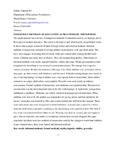| dc.description.abstract | This paper presents an overview of indigenous methods of education used by the kipsigis and its
Relevance to modern education. The article is descriptive and relied heavily on published works.
It shows that kipsigis instructed children through formal and informal methods. Informal
methods of instructions included involving children in productive work and observation. The
boys were engaged in looking after livestock while girls looked after younger brothers and
sisters. Children also learnt how to observe. They also learned through play. Other forms of
informal methods were myths, legends folklores, riddles and songs. Myths are regarded as tales
imaginatively describing or accounting for natural phenomena. The kipsigis had songs for
various occasions .Besides the numerous folksongs with which children were associated with as
they grew up, there existed rich children’s oral literature. Folktales among kipsgis were based on
day to day happenings. Asking of riddles was a very special form of amusement. Some riddles
seemed to be simple while others were complex. Proverbs were used wisely in ordinary
conversation. Formal methods of instructions were initiation and apprenticeship. The period of
circumcision was the most important time in the life of the kipsigis. It marked the passage from
childhood to adulthood. Medicine was widely practiced in kipsigis pre-colonial times. When
children were sick or ill, the mother was responsible for giving advice and first aid before the
father’s assistance was resorted to. Men and women learned this skill from their parents. There
were individuals who were recognized as better herbalists. A person who wanted his child to
learn the skills from a specialist would pay a fee and training took a period of time .The skill of
iron work was transmitted from father to son .Weaving was done by women and was taught to
girls .The art of pottery was learnt by the kipsigis women from luo and Abagusii.The paper
concludes that there were two methods of instructions used by the kipsigis to teach their children
in pre-colonial times; these were formal and informal methods. | en_US |

